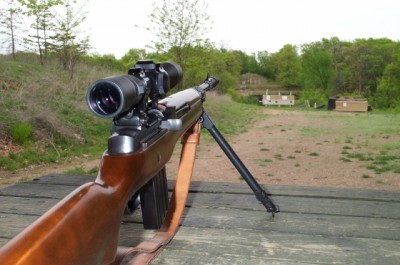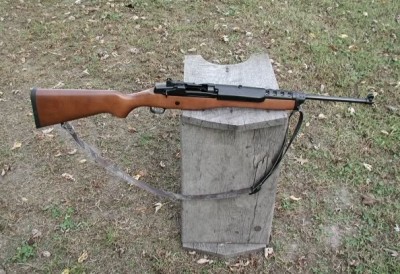It doesn’t get much more American than the old Ruger Ranch Rifle: the Mini-14. This tiny M1-style carbine weapon was designed to be amazingly rugged, especially considering how it was originally crafted for the whacking of sly coyotes on the open range.
In the days before amateur, high-precision shooting from the bench, gun consumers weren’t too concerned about these newfangled “MOA”-grouping things. Overall, folks in those days tended to be rather happy with their rifle, so long as they were able to nail one of mother’s pie plates at 75 yards off. So it was, in 1973, Ruger gave their loyal customers exactly what they wanted: a semi-auto, magazine-fed, piston-powered carbine rifle.
Its design provided the wondrously sturdy benefits of those old Garand actions (like the kind that Grandad carried during the war), yet also toned down the caliber from a 30-06 to take a .223 Rem cartridge. The beauty of this smaller cartridge was the fact that it was far more recoil-manageable and ideal for taking smaller-sized game and predators. And its high velocities provided a lofty helping of…
… accuracy … right.
Which Mini-14 Are We Talking About?
As more and more folks took it to the range, that lofty helping of accuracy seemed to offer far less of a satisfying serving than most had hoped for. When you’re struggling to hit a foot-wide target at 100 yards after being plagued with fliers, you start to wonder why. Since all Ruger Mini-14 owners can’t be horrible shooters, people started to realize it was the rifle.
It’s been quite a long time since Ruger was faced with those first customer complaints. And to the delight of Ruger fans nationwide, the manufacturer decided to listen in 2005 (it only took them 32 years). Bart Skelton’s article in Rifle Shooter told the tale of the Mini-14 reborn:
“Chatter about the accuracy issues of the Mini-14 has never gone unnoticed by the company, and the engineers have worked long and hard to alleviate the issues. It appears they may have reached that happy medium between accuracy, reliability, handiness and cost effectiveness in their new and improved Mini-14. Some are referring to the new rifle as the “580,” referring to the three-digit-series number that appears ahead of the serial number.”
Vicious New Hand-Held Self-Defense Tool Turns Lethal In Seconds!
The 580 became the new standard of Mini-14, meaning that those old models – and their accuracy issues – could be left in the past. From 2006 onward, the new Ruger ranch rifle shall no longer be subject to the annoyance of precision-obsessed shooters, since it’s now amazingly…
…accurate … right.
What gives, Ruger?!
Old Demons Die Hard
Well, first thing’s first, let’s have a look at the problems that plagued Ruger’s original 1973 Mini-14. Perhaps the most pronounced issues that the pre-580 series rifle faced actually boiled down to production flaws, where the factory got a little sloppy. There also seems to have been a general misunderstanding of customer expectations. For instance:
- Gas block defects. This had caused more than a few fliers in its day. Ruger would often produce Mini-14s with gas blocks that had inconsistent contact with the barrel, thereby distorting its harmonics. This is why many gunsmiths would remove the gas block and shave off some metal, so that it would have a better fit against the barrel.
- Tolerances in general. Overall, Ruger’s production of the old Mini-14 could be unfortunately described as somewhat careless, which was largely the reason for the rifle’s obscenely large tolerances. Even the rifle’s front iron sight was stamped into the barrel itself, which often caused it to bend near the crown, thereby hamstringing its accuracy.
- Philosophical underpinning. Ruger wasn’t really convinced that the Mini-14 needed to be all that accurate in the first place, because it was meant for light hunting/sporting purposes and combative self-defense. Who needs a super accurate rifle while shooting at a living thing, right? Sheesh.
But then, Ruger listened, (almost) fixing these accuracy problems …but not totally.
Problems That Remained
In the newer 580-series rifles, Ruger actually did a fantastic job at tidying up their design, their production methods and especially the rifle’s tolerances. It simply became a better weapon. But then, there’s this thing called physics:
- The power of harmonics. When the firing pin slams forward, the action jerks backward and the round slams into the rifling grooves, what do you get? A MASSIVE amount of vibrational play in the barrel itself, causing it to ripple like a wave (especially if the barrel isn’t nearly thick enough to handle the chaos).
- Trigger creep. In those moments before the round goes off, 580-series Mini-14 Rugers are haunted by a creeping 5.43lb trigger pull. Some might be OK with that, but this has been a point of notable contention in recent years.
- The fundamental design underpinning. Ultimately, the reason why I believe that the Ruger Mini-14 has been plagued with accuracy issues from its inception (even back into 1973), is due to the fact that the rifle uses an extremely chaotic M1-style action, complete with rotating metal parts that racket and flail back and forth. While this might have been a positively ideal semi-auto loading mechanism for a sturdy .308 or 30-06, physics is going to cause inherent problems for a much lighter carbine-length rifle, much like the notoriously inaccurate pre-mod AK-47. Either you’ve got to overbuild it or dampen the chaos and thicken that barrel.
And it’s by dampening the chaos that we give the Mini-14 its new lease on life. Balance and harmony are wonderful things. And it’s always good to be non-creepy, especially when we’re talking triggers.
Let’s Give the Mini-14 Some Accuracy Love
I will say that the 580-series Mini-14s have already come a VERY long way from the accuracy problems that once hogtied the rifle’s reputation. At this point, all we really need to do is address the remaining factors. Let’s start with the most obvious one: the barrel.
1. The accu-strut dampener. So what can bad harmonics actually do to a barrel, at least enough for a shot at Mr. Coyote to actually miss him entirely? Well, here’s a description from Brownells on what truly is going on: “These vibrations result in the barrel moving in an uncontrollable arc. If these barrel vibrations were consistent from shot to shot, only human error would stop your shots from becoming one-hole groups. Unfortunately, these vibrations vary in magnitude and duration from shot to shot and result in inconsistent accuracy.”
So, not only does this make for inaccurate shots, but this inaccuracy is even unpredictable.
How can this be fixed? Simple: Stabilize it. Perhaps the one product, which saved the legacy of a 50-year-old rifle (in terms of accuracy anyway), is the Accu-Strut. This $100 product clamps onto the barrel and fits up under the gas block, thereby dampening that nasty uncontrollable arc.
2. No Easy Solution For a Trigger Issue – Unfortunately, fixing this trigger issue is going to require gunsmith-level skills. More often than not, customers ship the rifle back to Ruger for the fix. But this tends to result in a hassle and an overly long wait. However, for anywhere from $70 to $150, a gunsmith should be able to take your Mini-14 and do away with the creeping, heavy trigger pull.
There just isn’t an easier way to deal with this problem, unless you have the practical knowledge and skillset of a gunsmith. Other than that, you’re probably going to have to get used to the creep. At least the Accu-Strut has resolved the Mini-14’s issues with physics.
Come on Back to the Basics
Let’s come back to the philosophy behind the Ruger Ranch Rifle’s production in the first place. Granted, Ruger has produced a Mini-14 “target” model. But honestly it would still not be my choice TAC driver for a competition … with or without that Class III NFA-looking harmonic dampener on the end.
She’s a ranch rifle, built tough. Of course, we don’t want some uncontrollable arc movement in our barrel to blow a shot at the canine devil that’s been after our hens. But sometimes hitting one of mother’s pie plates at 75 yards off might not necessarily be a bad test of accuracy. Some rifles are at home on the bench.
What do you think? Does the Mini-14 have a problem that needs to be fixed? Share your thoughts in the section below:
Pump Shotguns Have One BIG Advantage Over Other Shotguns In Self-Defense. Read More Here.
 Off The Grid News Better Ideas For Off The Grid Living
Off The Grid News Better Ideas For Off The Grid Living






